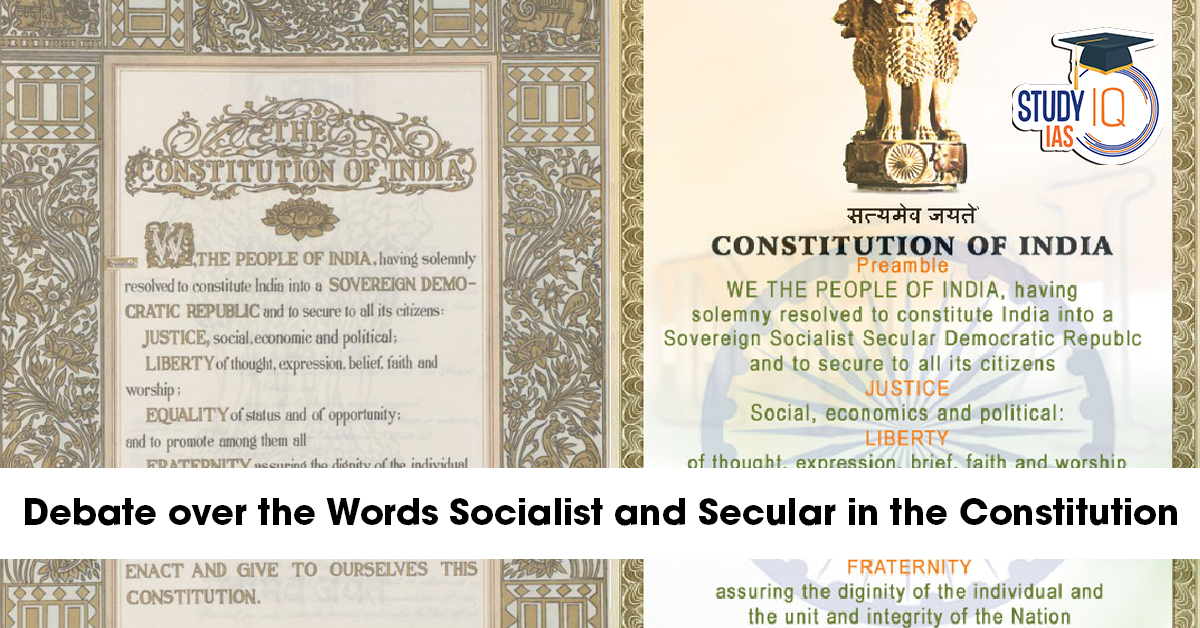Context: Vice President Jagdeep Dhankhar stated that the inclusion of the words “socialist” and “secular” in the Preamble of the Constitution during the Emergency era was a “sacrilege to the spirit of Sanatan.”
What is meant by Secularism in the Constitution?
- It is the principle that guides the relationship between the state and religions, ensuring that the state remains neutral in religious matters.
- It restricts the influence of religious institutions in the functioning of the state and guarantees equal treatment and freedom to followers of all religions.
Chronology of the Term “Secularism” in the Indian Constitution
| Year/Period |
Event/Case |
Development regarding Secularism |
| 1946–1950 |
Constitution drafting |
Secular principles embedded, word not included |
| 1950 |
Constitution adopted |
Preamble omitted the word “secular” |
| 1973 |
Kesavananda Bharati case |
Secularism declared a “basic feature” |
| 1976 |
42nd Amendment |
“Secular” inserted in the Preamble |
| 1994 |
S.R. Bommai case |
Reaffirmed secularism as a “basic feature” |
| 2024 |
Supreme Court ruling |
Challenge to inclusion of “secular” dismissed |
Is secularism anti-religious?
- Secularism means the state has no official religion and treats all religions equally.
It protects religious freedom for everyone, allowing individuals to practice, profess, and propagate any religion or none at all.
- In the Indian context, secularism is not against religion, but rather ensures that no religion is given special preference by the state.
- Secularism is neutral towards religion—it is neither pro-religion nor anti-religion.
|
Constitutional Provisions Related To Indian Secularism
|
| Article |
Provision |
Secular Principle |
| Article 14 |
Equality before the law and equal protection under the law |
Prohibits discrimination by the state on religious grounds. |
| Article 15 |
Prohibits discrimination on grounds of religion, race, caste, sex, or place of birth |
Ensures equal access to public spaces and opportunities regardless of religion. |
| Article 16 |
Equality of opportunity in public employment |
Forbids discrimination based on religion in government jobs. |
| Article 17 |
Abolishes untouchability |
Promotes social equality, including among different religious groups. |
| Article 25 |
Freedom of conscience and the right to freely profess, practice, and propagate religion |
Guarantees individual religious freedom, subject to public order, morality, and health. |
| Article 26 |
Freedom to manage religious affairs |
Religious denominations can manage their own affairs in matters of religion. |
| Article 27 |
Freedom from taxation for the promotion of any particular religion |
No person can be compelled to pay taxes for the promotion of a religion. |
| Article 28 |
Prohibits religious instruction in state-funded educational institutions |
Ensures state neutrality in educational settings. |
| Article 29 |
Protection of the interests of minorities |
Safeguards the right of minorities to conserve their culture and religion. |
| Article 44 |
Advocates for a Uniform Civil Code for all citizens |
Promote secular governance in matters of personal law, though it is not yet implemented |
Is Secularism against both Inter and Intra Religious domination?
- Against Inter-Religious Domination: Secularism opposes any situation where one religion dominates or discriminates against another.
- It emphasises equal respect and protection for all religions.
- Example: The Indian Constitution prohibits discrimination based on religion (Article 15).
- Against Intra-Religious Domination: Secularism opposes oppression or domination within a single religious group.
- It allows the state to intervene if practices within a religion infringe on basic human rights, dignity, or equality.
- Example: Abolishing untouchability and reforming personal laws in India (e.g., Sati abolition, Triple Talaq judgment).
Difference Between Indian and Western Secularism
| Aspect |
Indian Secularism |
Western Secularism |
| Definition |
Equal respect and treatment for all religions; not anti-religion |
Complete separation between religion and state |
| Role of State |
The state may intervene in religion to ensure equality and reform |
The state maintains strict non-interference in religious matters |
| Religious Freedom |
Guarantees religious freedom for both individuals and minorities |
Focus on individual religious freedom |
| Law and Religion |
Law accommodates diverse religious practices (personal laws, etc.) |
Laws are formulated independently of religious principles |
| Educational Institutions |
Religious minorities can run and receive aid for their own institutions |
The state cannot fund religious educational institutions |
| State Involvement |
The state can engage with religions for reform and social justice |
The state intervenes only if religion violates the law |
| Uniformity of Laws |
Personal laws vary by religion (e.g., marriage, inheritance) |
Single, uniform code of law for all citizens |
| Social Structure |
Multi-religious, multi-caste society; focus on both inter- and intra-religious equality |
Predominantly mono-religious; the focus is usually intra-religious |
| Minority Rights |
Explicit protection and promotion of minority religious rights |
Minority equality is often less emphasised |
| Political Influence |
Religious groups can influence politics and voting |
Minimal influence of religion in political processes |
| Expression of Religion |
Open practice and public display allowed |
Public display discouraged; religion is mostly private |
What are the Challenges Associated with Secularism in India?
- Communalism and Religious Violence: Many of these riots were triggered during religious festivals or over contested places of worship, resulting in deaths and targeted violence.
- Eg. In 2024, India witnessed an 84% increase in communal riots compared to the previous year.
- Politicisation of Religion: Religious identity is used as a political tool to influence public opinion and elections.
- Eg., the Babri Masjid demolition in 1992 and subsequent political mobilisation around the Ram Janmabhoomi movement.
- Discrimination Against Minorities: Anti-conversion laws (e.g., MP, UP) and anti-cow slaughter laws are often used to discriminate against Muslims, Christians, and Dalits, affecting their livelihoods and religious freedoms.
- Educational & Cultural Bias: Secular values are undermined when educational content favours a single religious narrative.
- Eg., NCERT textbook revisions accused of “saffronisation” skew historical understanding and marginalise minority perspectives.
- Societal Challenges: Deep-seated prejudices, myths, and stereotypes about religious groups continue to fuel divisions.
Way Forward
- Promote Constitutional Values through Education: Integrate secular and constitutional values in school curricula and textbooks.
- Encourage critical thinking and respect for diversity among students.
- Example: Programs like “Ek Bharat Shreshtha Bharat” promote cultural understanding.
- Impartial Enforcement of Laws: Ensure the law is applied equally to all, regardless of religion or community.
- State institutions (police, courts, administration) must act without bias, especially during communal tensions.
- Example: Quick action against hate speech and violence, regardless of the perpetrator’s religion.
- Curb Politicization of Religion: Strengthen the Election Commission’s role to monitor and penalise religious appeals in politics.
- Disallow political parties from seeking votes in the name of religion (as per the Supreme Court’s 2017 guidelines).
- Promote Interfaith Dialogue and Social Harmony: Facilitate platforms for interfaith dialogue at local, regional, and national levels.
- NGOs, community leaders, and media can play a vital role in dispelling myths and fostering understanding.
- Reform Personal Laws for Uniformity: Move towards a Uniform Civil Code in a consultative, gradual manner to ensure equality while respecting diversity.
- Focus on gender justice and human rights, not on undermining any community’s identity.
- Safeguard Minority Rights: Actively protect the rights and interests of religious minorities to prevent alienation.
- Ensure minority educational and cultural institutions are free from discrimination and undue interference.
- Promote Inclusive Development: Address economic and social marginalisation of any community to reduce grievances that fuel religious divides.
- Example: Focused government schemes for minority welfare, scholarships, and skill development.
- Media Responsibility: The Media should report sensitively and avoid sensationalism on religious issues.
- Encourage media literacy to counter misinformation and hate speech online.
| PREVIOUS YEAR QUESTIONS |
- Discuss India as a secular state and compare it with the secular principles of the US Constitution. [2024]
- Are tolerance, assimilation and pluralism the key elements in the making of an Indian form of secularism? Justify your answer. [2022]
- What are the challenges to our cultural practices in the name of secularism? [2019]
- How is the Indian concept of secularism different from the Western model of secularism? Discuss. [2018]
- How do the Indian debates on secularism differ from the debates in the West? [2014].
|
Sharing is caring!


 SLAPP Suits: Meaning, Examples, Impact o...
SLAPP Suits: Meaning, Examples, Impact o...
 Finance Commission of India, Articles an...
Finance Commission of India, Articles an...
 High Number of Pending Cases in Supreme ...
High Number of Pending Cases in Supreme ...

























